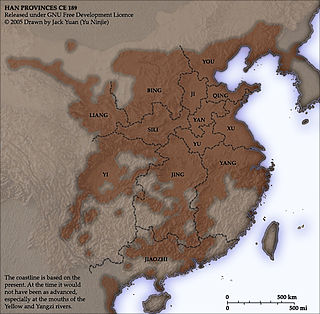
Anguo, nicknamed "Medicine Capital" (药都), is a county-level city under the administration of and 52 kilometres (32 mi) south of Baoding, central Hebei province, China.

Xu Shouhui was a 14th-century Chinese rebel leader who proclaimed himself emperor during the late Mongol Yuan Dynasty period. He was also known as Xu Zhenyi.

Prefectures, formally a kind of prefecture-level divisions as a term in the context of China, are used to refer to several unrelated political divisions in both ancient and modern China. There are 334 prefecture-level divisions in China. They include 7 prefectures, 293 prefecture-level cities, 30 autonomous prefectures and 3 leagues. Other than provincial level divisions, prefectural level divisions are not mentioned in the Chinese constitution.

Wanzhou District is Chongqing's second most populated urban core area on the upper reaches of the Three Gorges of the Yangtze River in China. It is currently governed as a district of Chongqing Municipality, bordering Sichuan to the northwest and Hubei to the southeast. It was formerly known as Wanxian or Wan County. Prior to Chongqing's formation as a direct-controlled municipality, Wanzhou was part of Sichuan province. The urban core of Wanzhou is 228 km (142 mi) away from Chongqing's city proper.
The history of the administrative divisions of the Imperial China is quite complex. Across history, what is called 'China' has taken many shapes, and many political organizations. For various reasons, both the borders and names of political divisions have changed—sometimes to follow topography, sometimes to weaken former states by dividing them, and sometimes to realize a philosophical or historical ideal. For recent times, the number of recorded tiny changes is quite large; by contrast, the lack of clear, trustworthy data for ancient times forces historians and geographers to draw approximate borders for respective divisions. But thanks to imperial records and geographic descriptions, political divisions may often be redrawn with some precision. Natural changes, such as changes in a river's course, or loss of data, still make this issue difficult for ancient times.

Xiangxi Tujia and Miao Autonomous Prefecture is an autonomous prefecture of the People's Republic of China. It is located in western Hunan province. It consists of 1 city, Jishou, and 7 counties: Baojing, Fenghuang, Guzhang, Huayuan, Longshan, Luxi, Yongshun. The capital is Jishou. Twenty-five nationalities gather here, of the total 2,480,000 population, 66.6 per cent are ethnic minorities, including 860,000 Tujia and 790,000 Miao.

Meishan (Chinese: 眉山; Sichuanese Pinyin: Mi2san1; local pronunciation: [mi˨˩sã˥]; pinyin: Méishān; Wade–Giles: Mei-shan), formerly known as Meizhou (眉州) or Qingzhou (青州), is a prefecture-level city with more than 3,000,000 inhabitants in Sichuan province, China. Meishan is in the southwest of Sichuan Basin.

Luotian County is located in the northeast of Hubei province, China and it is under the administration of Huanggang City. The county is on the south side of the Dabie Mountains with the highest peak, Tiantangzhai, situated in the northeastern part of the county. Luotian county covers an area of 2,144 square kilometres (828 sq mi) and had a population of about 600,000 in 2016. The Dabie Mountains attract thousands of tourists from all over the province every year and the most popular tourist sites include Tiantangzhai National Forest Park, Bodaofeng National Forest Park, and Sanlifan Hot Spring.

Zhong County or Zhongxian is a county of Chongqing Municipality, China.
The Roman Catholic Diocese of Qizhou/Kichow/Qichun is a diocese located in the city of Qizhou in the Ecclesiastical province of Hankou in China.

Lianzhou, formerly Lian County or Lianxian, is a county-level city in northern Guangdong Province, China, and is the northernmost county-level division of the prefecture-level city of Qingyuan. It is known as the host city of the Lianzhou International Photography Festival (LIPF) and as a historic and cultural landmark of Guangdong Province.
Yangzhou, Yangchow or Yang Province was one of the Nine Provinces of ancient China mentioned in historical texts such as the Tribute of Yu, Erya and Rites of Zhou.
Tanzhou or Tan Prefecture (潭州) was a zhou (prefecture) in imperial China centering on modern Changsha, Hunan, China. In the Yuan dynasty it was known as Tanzhou Route (潭州路) and in the Ming dynasty as Tanzhou Prefecture (潭州府). It existed (intermittently) from 589 to 1372.
Qizhou or Qi Prefecture (祁州) was a zhou (prefecture) in imperial China centering on modern Anguo, Hebei, China. It existed from 893 until 1913.
Qizhou or Qi Prefecture (齊州) was a zhou (prefecture) in imperial China centering on modern Jinan, Shandong, China. It existed (intermittently) from 469 until 1116.
Qizhou (歧州) was a prefecture between the 5th and 8th centuries in modern Shaanxi, China
Teochew or Chiuchow is an area in eastern Guangdong, China which contains Chaozhou, Shantou (Swatow) and Jieyang (Kityang) cities under new administrative division of PRC government made to former Teochew prefecture established in Qing dynasty.












